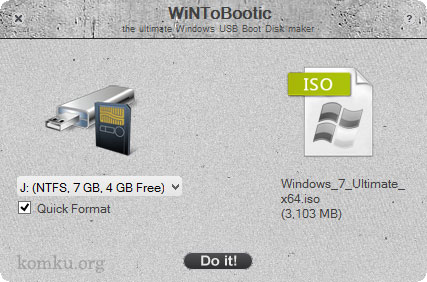How To Make A Bootable Usb Windows 7 Installer
Advertisement I recently bought a nice new setup for my media centre, but I didn’t want to splash out on another DVD drive when physical media is basically dead – and swapping out a DVD drive from another machine just to install Windows seems like such a waste of time when I could be eating Christmas pudding. While Windows 8 is slated to allow media-less upgrade, today I’ll outline a relatively easy way to make a bootable Windows installation USB drive, without having to download additional software. If your Christmas PC budget didn’t quite stretch to a DVD drive, this is the tutorial for you. We described a before, but it required a few external utilities. This time I’ll assume you have a working Windows 7 computer with an existing DVD drive somewhere – and a working installation DVD to go with it. You’ll use this machine to format, set up, and copy over the relevant files to a USB stick. You could also do this without a DVD drive from the ISO, but in that case your job would be a whole lot simpler because you could use the official ISO ->USB creator.
Note: You cannot use this method to install to a Parallels virtual machine. Your only option in that case is to use either a physical DVD or an ISO download and connect to that to the VM instead. You’ll need: • A working Windows 7 system with a DVD drive and administrator rights. • A Windows 7 installation DVD.
• 4GB USB drive or larger. This will also work with larger external hard drives instead of a USB thumbdisk, but be aware that all the data on the drive will be formatted and deleted. Open an Elevated Command Prompt Click Start ->All Programs ->Accessories and right-click on Command Prompt. Select Run As Administrator. The Rafael Mendez Collection Pdf Free. Of course, you need to be able to authenticate as the administrator on the PC you’re using. LIST DISK Figure out which of the drives listed is your USB drive, and note the number. It’s crucial you get this right, or you’re going to end up losing data on other drives.
Oh, and Rufus is fast. For instance it's about twice as fast as UNetbootin, Universal USB Installer or Windows 7 USB download tool, on the creation of a Windows 7 USB installation drive from an ISO. It is also marginally faster on the creation of Linux bootable USB from ISOs. A non exhaustive list of Rufus supported ISOs is. Looking for bootable usb drive maker, installer or creator software for Windows 7? These tools let you install Windows 7 from USB easily.
Next, type the following series of commands, but replace the DISK number in the first line with the appropriate number from the above list. Here, my disk is number 1. Don’t confuse this with PARTITION 1.
That number should not change, even if your disk is 3. SELECT DISK 1 CLEAN CREATE PARTITION PRIMARY SELECT PARTITION 1 ACTIVE FORMAT FS=NTFS ASSIGN EXIT. Copy Everything The final step can be done from My Computer. Just open up the installation DVD, highlight everything, and drag it over to your USB drive. This will also take a while.
Now you should be all set – just insert the USB disk into your new PC, and enter the BIOS to adjust the boot order, or choose the option during start up which says Choose Boot Device. Let’s hear it for computers with no noisy and clunky DVD drives! Death to physical media! Or not – what do you think? Are you ready to go DVD-less?
